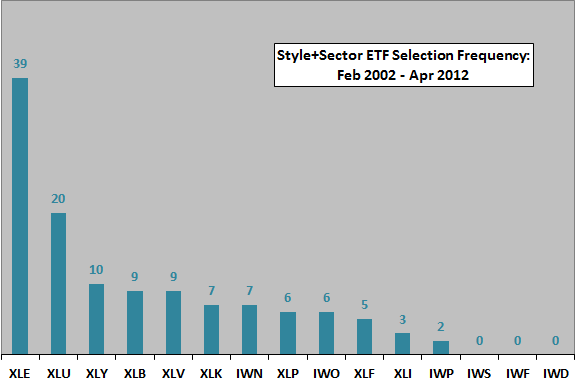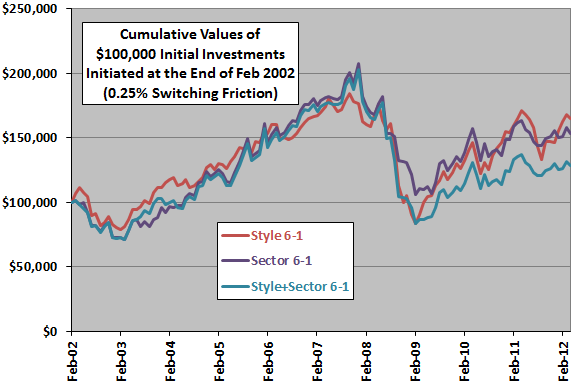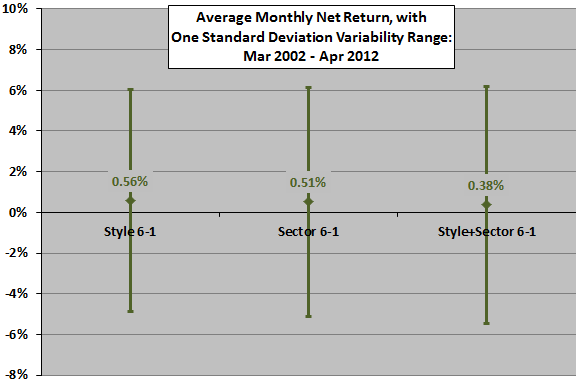A subscriber commented and asked: “You compare style ETF momentum to sector ETF momentum in ‘Doing Momentum with Style (ETFs)’. Can you mix style and sector ETFs to form a combined momentum strategy and compare it with the individual style and sector momentum strategies?” A combined strategy encompasses the nine sector exchange-traded funds (ETF) defined by the Select Sector Standard & Poor’s Depository Receipts (SPDR) plus the six ETFs that cut across market capitalization (large, medium and small) and value versus growth:
Materials Select Sector SPDR (XLB)
Energy Select Sector SPDR (XLE)
Financial Select Sector SPDR (XLF)
Industrial Select Sector SPDR (XLI)
Technology Select Sector SPDR (XLK)
Consumer Staples Select Sector SPDR (XLP)
Utilities Select Sector SPDR (XLU)
Health Care Select Sector SPDR (XLV)
Consumer Discretionary Select SPDR (XLY)
iShares Russell 1000 Value Index (IWD) – large capitalization value stocks.
iShares Russell 1000 Growth Index (IWF) – large capitalization growth stocks.
iShares Russell Midcap Value Index (IWS) – mid-capitalization value stocks.
iShares Russell Midcap Growth Index (IWP) – mid-capitalization growth stocks.
iShares Russell 2000 Value Index (IWN) – small capitalization value stocks.
iShares Russell 2000 Growth Index (IWO) – small capitalization growth stocks.
We consider a simple (6-1) strategy that allocates all funds each month to the one sector or style ETF with the highest total return over the past six months (effectively pitting the sector winner against the style winner). Using monthly dividend-adjusted closing prices for these 15 ETFs over the period August 2001 (limited by data availability for IWS/IWP) through April 2012 (129 months), we find that:
The following chart presents the distribution of winning ETFs based on past six-month momentum over the available sample period. The XLE energy sector ETF comprises 39 of the 123 monthly winners (32%). Style ETFs win only 15 months, and large capitalization stocks never win. The returns of all these U.S. equity ETFs are highly correlated. The sector ETFs are more finely segmented than the style ETFs, so they are generally more volatile and therefore more likely to win on momentum.
How does applying the 6-1 combined style and sector ETF momentum strategy translate into cumulative returns?

The next chart compares the cumulative values of $100,000 initial investments in each of the sector ETF, style ETF and combined 6-1 momentum strategies over the available sample period. Calculations derive from the following assumptions:
- Reallocate at the close on the last trading day of each month (assume that total six-month past returns for the ETFs can be calculated just before the close).
- Trading (switching) friction is 0.25% of the balance whenever there is an ETF switch.
- Ignore any tax implications of trading.
At the assumed level of switching friction, the net style ETF momentum strategy (Style 6-1) and net sector ETF momentum strategy (Sector 6-1, from “Simple Sector ETF Momentum Strategy”) perform similarly. The combined strategy (Style+Sector 6-1) underperforms due to a few unlucky switches during the 2008-2009 market crash and elevated trading frictions.
The number of switches for the combined strategy is 53, compared to 38 for Style 6-1 and 49 for Sector 6-1.
How do average monthly returns, as alternative measures of strategy performance, compare?

The final chart depicts the average monthly net returns (with 0.25% switching frictions) and the standard deviations of monthly returns for the three sector ETF momentum strategies. As indicated by the above cumulative performance, Style 6-1 and Sector 6-1 have similar statistics, with the combined strategy lagging.

In summary, evidence from simple tests indicates that a combined U.S. equity style and sector ETF momentum strategy underperforms the separate style and sector ETF momentum strategies due to a few unlucky switches and elevated trading friction.
In other words, more choices are not always better for a momentum strategy.
Cautions regarding findings include:
- Sample size is modest (about 22 independent six-month momentum ranking intervals).
- The selected ETF ranking interval derives from prior academic studies that most often use six-month and 12-month ranking intervals, with one-month holding intervals. This prior research may impound (and therefore transmit) data snooping bias, which is especially pernicious for small samples. Ranking intervals other than six months and holding periods other than one month may produce different results. For the above tests, using longer ranking and holding intervals would effectively reduce the already-small sample size. Optimizing the ranking and holding intervals would elevate data snooping bias.
- Including ETFs representing other asset classes (such as bonds, commodities and international stocks) may enhance results, but may also increase number of position switches and therefore cumulative trading friction.
- Potential wildness in ETF monthly return distributions limits confidence in results.